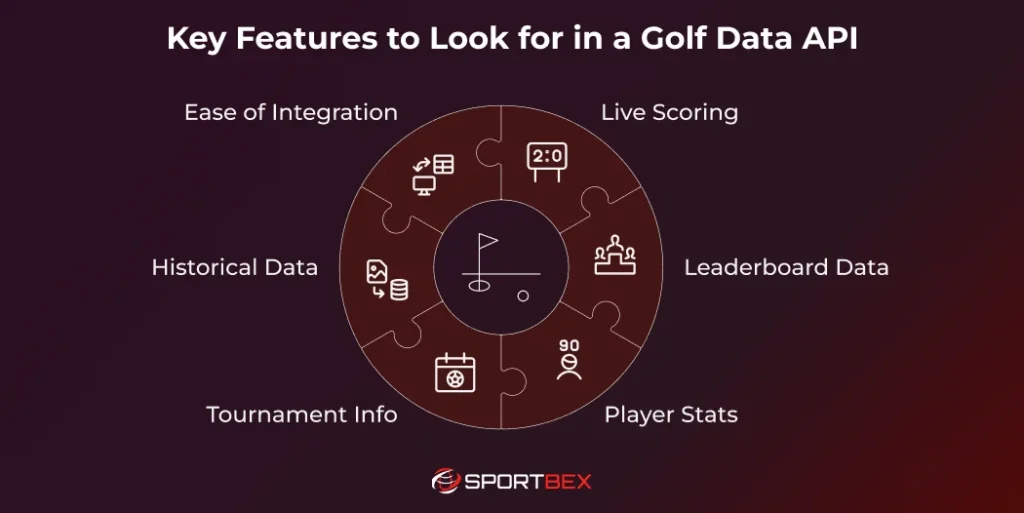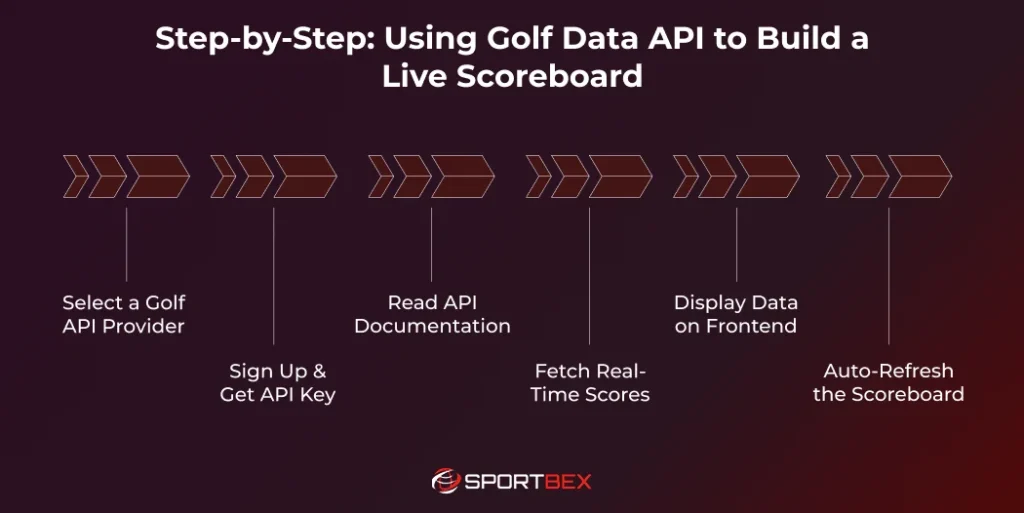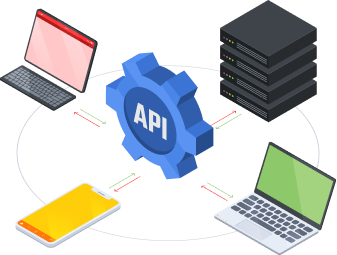Golf APIs have transformed how scores and updates are shared. Instead of manual tracking, everything is now automated and updated in real time. This allows developers, businesses, and fans to create real-time scoreboards quickly and easily.
Demand for real-time golf data is growing quickly. Betting platforms need live scores for odds and payouts. Fantasy apps use stats to engage users. Golf clubs, tournaments, and media depend on accurate data for fans and coverage. A Golf API seamlessly provides real-time Sports data across platforms.
Building a live golf scoreboard seems tricky, but Golf Data APIs make it easy by delivering data so you can focus on the user experience. The key is understanding how to use Golf Data API to build real-time scoreboards, what features to look for, and how to use them properly.
This guide covers the key features of a Golf Data API, setup steps, and tips to keep your scoreboard running smoothly. From real-time scoring and player stats to seamless integration, you’ll have everything you need to deliver accurate golf data to your audience.
What Is a Golf Data API?
A Golf Data API links golf databases to your apps, giving you easy access to detailed golf information. These APIs pull data from tournaments, stats organizations, and real-time scoring systems, simplifying golf data retrieval.
They cover major tours like the PGA, European, and LPGA Tours, along with other circuits. You’ll find both historical data—like past tournament results—and live updates as players complete each hole, perfect for apps that need both context and real-time info.
Golf scoring updates at intervals, unlike other sports. These APIs are designed for this, making them ideal for sports betting websites and ensuring accurate data across any tournament or time zone.
Most Golf Data APIs follow REST principles, making them easy to use with any programming language. They offer data in formats like JSON or XML, include error handling, and have clear documentation.
Why Real-Time Scoreboards Matter in Golf
Real-time scoreboards have transformed how fans follow professional golf. Previously, updates were slow, making it hard to stay connected. Now, instant updates keep fans engaged and excited during tournaments.
Real-time data is key for sports betting. Fast, accurate updates ensure fair bets and prevent issues like paused lines or lost revenue. In fast-paced sports like golf, real-time info is vital for fair betting.
Fantasy sports platforms rely on live scoring. Fantasy golf players crave shot-by-shot updates, especially during key moments. Delays frustrate users and hurt engagement. Real-time Sports Data and scoreboards with detailed stats keep the game fun and players coming back.
Finally, Real-time scoreboards show that an organization values technology and user experience. They emphasize accuracy, speed, and reliability, boosting satisfaction, attracting fans, and strengthening the brand.
Key Features to Look for in a Golf Data API

Live Scoring
A good Golf Data API should provide live scoring with real-time hole-by-hole updates, not just final scores. The best APIs update seconds after score verification, keeping your app up-to-date with the latest standings.
Top APIs clearly show the type of scoring update, including preliminary scores, verified official scores, and flags for reviews or penalties. This ensures accuracy and keeps users informed.
Leaderboard Data
A good leaderboard does more than rank scores. Look for APIs that show details like ties, position changes, and player movement during rounds. This creates clear visuals of progress and competition.
Advanced features include tracking the cut line, predicting eliminations, and comparing scores to par. Some APIs also let you filter leaderboards by rookies, international players, or past winners.
Player Stats
Player stats can transform scoreboards into powerful analysis tools. Look for APIs offering current tournament stats and historical data. Key metrics include driving distance, accuracy, greens in regulation, putting, and sand saves.
Advanced stats like strokes gained show how a player compares to the field in specific areas, revealing trends and insights beyond scores—perfect for fantasy sports, professional analysis, or enhancing your experience with a fantasy sports app.
Tournament Info
Tournament details are key to understanding scoreboard data. APIs should include info like course details, weather, prize money, player field, and format, so users can see how conditions affect scores.
Weather is key for golf, as wind, rain, and course conditions impact scoring and strategy. APIs with real-time weather and scores allow for better analysis and a smoother experience.
Historical Data
Access to historical tournament data is essential for analysis and understanding current performance. Choose APIs that include detailed archives with past results, player trends, and course stats over several years.
Historical data should match the current format for easy trend analysis and comparison. Consistency is key for tracking trends, predicting performance, and comparing stats over time.
Ease of Integration
Golf Data APIs vary in technical requirements, so pick one with clear resources. Good documentation, code examples, and simple integration guides can save time and prevent errors.
Focus on security and authentication. The API should follow standard security practices and offer simple, secure access controls. Complex authentication slows you down, and weak security risks your app.
Step-by-Step: Using Golf Data API to Build a Live Scoreboard

Select a Golf API Provider
Choosing the right API provider takes more than just checking basic features. Here’s what to look for:
- Data Coverage: Make sure the API includes tournaments your audience cares about, like the PGA Tour, European Tour, or LPGA.
- Data Quality: Test the API during live tournaments to check update speed and accuracy. Review sample data and documentation for reliability.
- Support: Good support matters. Check if the documentation is clear and how quickly they respond, especially during big events.
- Pricing: Pricing can be based on requests, subscriptions, or both. Consider your usage during major tournaments and plan for growth.
By evaluating these factors, you can choose the right API for your needs.
Sign Up & Get API Key
To get started with API Golf, create an account, choose a pricing plan, and grab your authentication credentials. Many users enjoy free trials or limited plans to test the platform before committing.
During registration, you’ll need to share details like your API use, expected traffic, and technical needs. This helps providers recommend the right plan and approve your application.
You’ll get an API key, which acts like a password for using the API. Keep this key safe—don’t share it in public or in your app’s client-side code.
Read API Documentation
Reviewing documentation is key to integrating an API successfully. Start with the overview to understand its structure, authentication, and usage rules. Check rate limits, as they impact real-time features.
Focus on the endpoint documentation for the data your scoreboard needs. Golf Data APIs have many endpoints, so knowing what you need avoids unnecessary calls.
Check the error handling section to see how the API reports issues. Golf data may have corrections or delays, so strong error handling is key to keeping things smooth for users.
Fetch Real-Time Scores
Getting golf scores takes planning to stay updated and within API limits. Most Golf Data APIs have endpoints with varying update speeds and details. Choose ones that give you the info you need without wasting resources.
Golf scores update after players finish holes, not continuously. Ensure your app handles errors like server issues or data feed problems. If issues occur, it should show the latest scores without crashing.
Display Data on Frontend
To create effective scoreboards, focus on clear, user-friendly design. Include basics like player names, scores, and rankings, and add more details only if there’s space and demand.
Make sure your scoreboard works on all devices. On mobile, keep it simple with key info, while on desktops, include extras like stats and past data. Design for updates that don’t disrupt the experience—avoid sudden changes or refreshes.
Auto-Refresh the Scoreboard
Set auto-refresh to balance accuracy and performance. Increase refresh frequency during busy tournaments to keep info updated.
Use smart refresh methods based on tournament activity. When no games are on, update less often to save resources while keeping basic features running.
Make sure refreshes don’t interrupt users while they are interacting with specific information.
Get a Ready-Made Platform On Rent.
Get Started Today
Conclusion
Real-time golf scoreboards bring tournament excitement to fans, bettors, and pros. With Golf Data APIs and smart development, we can create experiences that were impossible just a few years ago.
Golf technology is evolving with better data, stats, and new ways to present information. Using strong APIs and staying flexible ensures your scoreboard apps keep up and meet user needs.
A great golf scoreboard balances features with user needs. The best apps mix detailed info with simple interfaces, real-time updates with speed, and advanced tools with accessibility, suiting both casual fans and serious analysts.
Whether you’re using a Sports Data API, building tools for golf organizations, or creating fan apps, start with clear goals, the right tools, and a focus on user needs. Golf data offers exciting opportunities for creativity and engagement.
Frequently Asked Questions
A Golf Data API is used to access real-time or historical golf data, including scores, player stats, tournaments, and leaderboards. It’s ideal for powering apps, websites, and fantasy platforms.
Yes, most Golf Data APIs provide endpoints specifically for live scoring, making it easy to display real-time leaderboards and score updates on your site or app.
You can get live scores, player stats, tee times, tournament schedules, course info, and leaderboard rankings, depending on the API provider.
Some providers offer free tiers with limited data or usage, while others require paid subscriptions for full access to real-time and historical data.
Updates are usually in real-time or within a few seconds during active tournaments, depending on the provider’s latency and refresh rates.
Recent Blog
Top 10 Richest Clubs in FIFA Club World Cup 2025
August 19, 2025
 7 min
7 min
Top 10 Most Famous Handball Players in the World
August 19, 2025
 9 min
9 min








